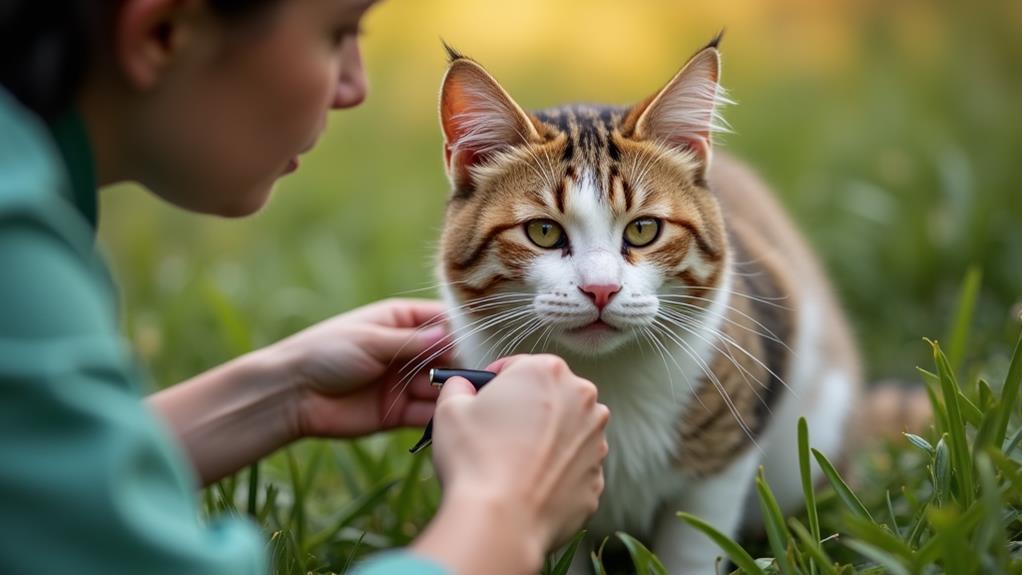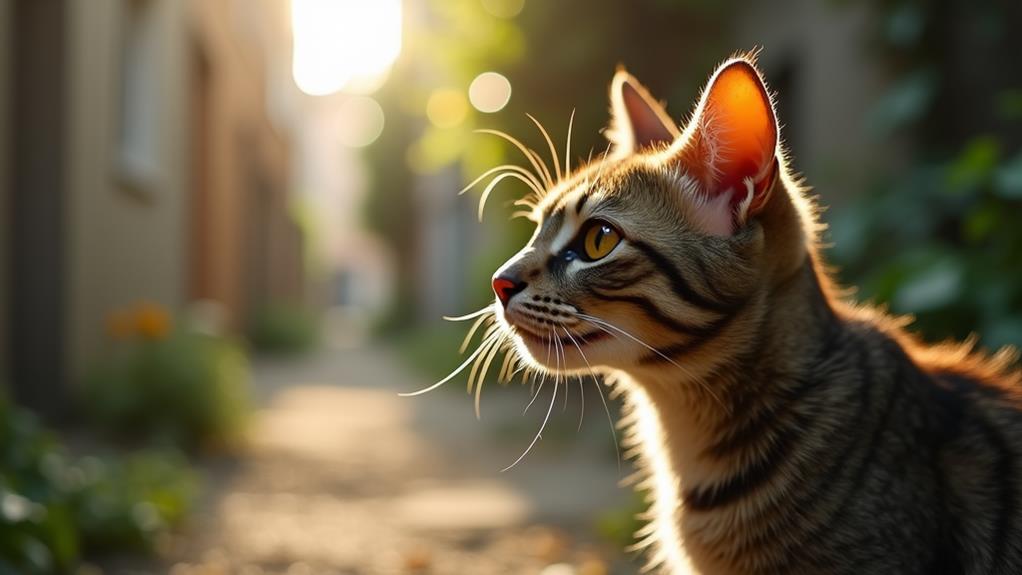What Is an Ear Tip for a Feral Cat? The Importance of Ear-Tipping in TNR

If you've ever seen a feral cat with a notched ear, that's an ear tip. It's a crucial part of TNR (Trap-Neuter-Return) programs. During their spay or neuter surgery, veterinarians remove about 1 cm from a cat's ear tip. This happens under anesthesia to guarantee no pain. Ear-tipping prevents unnecessary retrapping by marking sterilized cats, helping control the feral cat population naturally. It also plays a role in community health by maintaining stable feral cat numbers and offering natural pest control. Curious about the broader benefits and procedures involved? There's more to uncover about this humane approach.
Understanding Ear-Tipping
Ear-tipping is an essential practice in managing feral cat populations through TNVR programs. When you encounter community cats, an ear tip offers a quick, visual clue that the cat has been spayed or neutered and is part of these management efforts. This small surgical procedure involves the removal of about 1 cm from the cat's ear tip during their spay or neuter surgery. It's an efficient method for identification, distinguishing between sterilized and unsterilized feral cats from a distance.
In TNVR programs, the right ear is tipped for female cats, while the left ear is for males. This differentiation allows you to easily identify the gender and sterilization status of the community cats without needing to get too close, minimizing both their stress and yours as a caretaker or volunteer. The procedure is performed under anesthesia, ensuring the cat experiences minimal discomfort and heals swiftly.
Benefits of Ear-Tipping
While understanding ear-tipping provides insight into how it's done, recognizing its benefits highlights why this practice is so valuable in managing feral cat populations. An ear notch serves as a universal identification marker, letting you know at a glance that a community cat has already been through spay or neuter surgery and vaccination. This simple visual cue helps avoid unnecessary trapping and stress for these feral cats, allowing you to efficiently manage your efforts and resources.
Ear-tipping isn't just about identification; it's an essential tool for population management. By marking cats that have been altered, you help prevent the influx of new, unaltered cats into the community. This contributes to a more stable population, reducing the number of kittens born and ultimately decreasing the total feral cat numbers over time.
Moreover, ear-tipping is performed during spay or neuter surgeries, causing minimal pain and healing quickly, ensuring it's a safe practice. Communities that accept ear-tipping benefit from natural rodent control, as these cats help maintain a balanced ecosystem. By supporting this practice, you contribute to a harmonious coexistence between feral cats and the community.
Ear-Tipping Procedure

When managing feral cat populations, one important step involves the ear-tipping procedure. This process is significant for identifying spayed or neutered cats within a community. During the ear-tipping procedure, approximately 1 cm is surgically removed from the tip of the left ear for male cats. This universal marker helps caregivers and community members easily identify which cats have already been through the Trap-Neuter-Vaccinate-Return (TNVR) program.
The procedure is performed under sterile conditions during the spay or neuter surgery. It guarantees minimal pain and bleeding, making it a relatively painless experience for the cat. A hemostat is applied across the ear to stabilize it, and a straight blade or scalpel makes a clean cut. Afterward, styptic powder is used to control any bleeding effectively.
Identification has proven important in managing feral cat populations humanely, and ear-tipping plays a significant role in this process. The tip of the left ear serves as a visual cue, indicating the cat has been altered and won't contribute to further population growth. Proper execution of this procedure guarantees the well-being of feral cats while supporting efforts to maintain a balanced community.
Community Impact
Identifying altered cats through ear-tipping not only benefits the cats directly but also has a significant impact on the communities they inhabit. Ear-tipped cats serve as clear markers of spayed/neutered and vaccinated community cats, making it easier for you and animal services to monitor populations effectively. This visible sign helps control feral cat populations by reducing the influx of new cats, which stabilizes local cat numbers and addresses overpopulation concerns. By knowing which cats are ear-tipped, caregivers can focus their efforts on unaltered cats, ensuring the entire community cat population is managed efficiently.
The presence of ear-tipped cats offers practical benefits like natural pest control. These community cats help manage rodent populations, which can reduce the need for chemical pest control methods. This not only makes your neighborhood a more pleasant place to live but also supports a healthier environment. Encouraging neighbors to leave ear-tipped cats undisturbed fosters a harmonious relationship between residents and the feral cat population, promoting humane treatment and coexistence. By understanding and supporting the role of ear-tipped cats, you contribute to a balanced and thriving community for both humans and animals.
Safety Considerations

How do we guarantee the safety of feral cats during ear-tipping? Initially, ascertain that the cats are anesthetized. This is vital as it allows the procedure to be performed without causing the cat stress or pain. During spay/neuter surgeries, ear-tipping is seamlessly integrated, making it a safe and humane practice for community cats. The process involves removing about 1 cm from the ear tip, which results in minimal bleeding and a swift healing process.
Using sterile techniques is another significant aspect. This minimizes the risk of infection, securing the safety of the cats. Moreover, applying hemostatic paste helps control bleeding, further enhancing the procedure's safety. These precautions make ear-tipping an effective and safe way to manage feral cat populations.
Ear-tipping also reduces stress for the cats. Once a cat is ear-tipped, it can be easily identified from a distance, eliminating the need for repeated trapping and anesthesia. This not only benefits the individual cats but also contributes positively to the general well-being of community cat colonies. By following these safety measures, we guarantee that ear-tipping remains a humane practice, benefiting both the cats and the communities they inhabit.
Supporting TNR Programs
Ear-tipping guarantees the safety and well-being of feral cats, but it's just one part of a larger strategy to manage these populations effectively. Supporting TNR (Trap-Neuter-Return) programs is crucial for controlling feral cat populations. These initiatives focus on spaying, neutering, and vaccinating cats, which reduces overpopulation and improves the general health of the community. When cats are trapped and already anesthetized for surgery, it's the perfect time to tip the LEFT ear. This small act can greatly alter their future by marking them as part of a managed colony.
Community involvement is key in making TNR programs successful. Volunteers play an important role by providing food, shelter, and medical treatment to feral cats, which helps lower the number of new litters and reduces associated costs. By participating in TNR efforts, you contribute to a sustainable solution that benefits everyone, including the cats and the community.
Education and awareness about the benefits of these programs encourage more people to get involved. Local organizations often collaborate with TNR programs, offering resources like spay/neuter services and vaccinations. This support improves the welfare of feral cats, allowing them to safely return to their habitats while maintaining natural rodent control.
Personal Stories and Successes

Although TNR programs focus on population control, the heartwarming personal stories from caregivers reveal a deeper impact on both feral cats and the communities they inhabit. Take Sweet Pea, for example. This cat, once considered unmanageable, transformed through TNR efforts. With her ear tip already marking her as part of the program, volunteers worked tirelessly to improve her health and socialization. The distance between Sweet Pea and humans gradually closed, thanks to dedicated foster volunteers providing a safe environment.
You might find yourself inspired by these personal stories. Caregivers often share emotional bonds formed with feral cats, illustrating not just a change in the cats' lives, but also a shift in community perspectives. They create unique adaptations for injured or special needs feral cats, ensuring their well-being. These efforts highlight the commitment to enhancing the quality of life for every cat involved.
Community involvement is key. Awareness campaigns promote the success of TNR initiatives, elevating public support and encouraging more people to participate in feral cat care. When you witness these transformations, the importance of ear-tipping becomes clear—it's a symbol of hope and positive change for feral cats everywhere.




